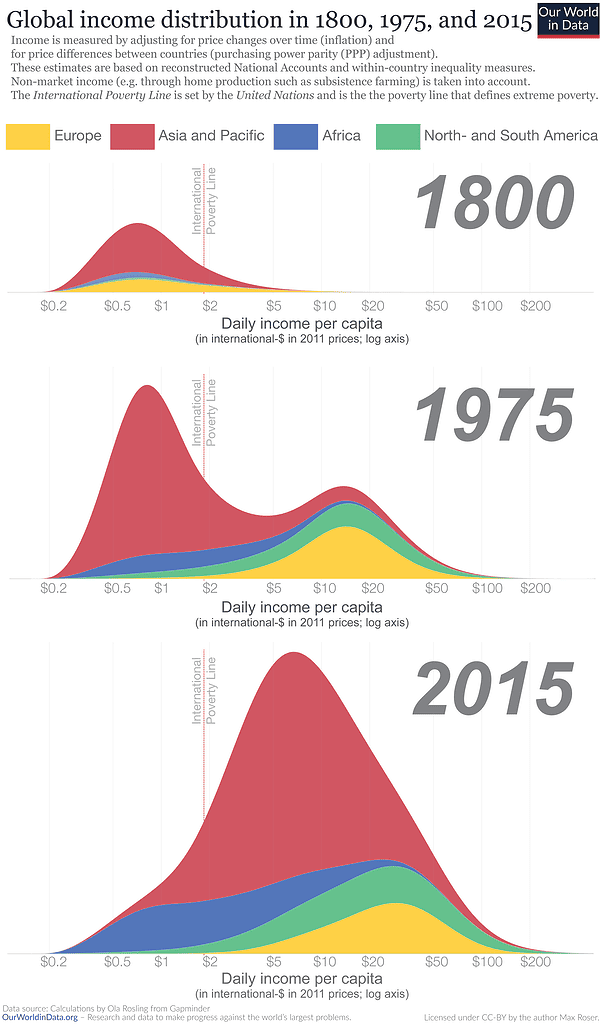The world is not exactly a good place; in many ways, it’s a terrible place. But it’s also a far better place than it used to be. Take poverty, for instance. A shocking 1.9 billion people live in poverty, and 700 million in extreme poverty. That’s 29% of the global population — a disturbing figure.
But compare it to what was happening a century or two ago. The rate of poverty used to be much higher and has steadily decreased (and is continuing to decrease). Part of this comes from the fact that the world is richer than ever before. However, simply having more money on average doesn’t necessarily mean poverty is reduced because the money can be distributed disproportionately to the rich. In fact, this is what we’re seeing nowadays with rising inequality, and yet poverty is on the decrease.
So what’s happening?

Free markets
The traditional narrative is that capitalism is happening. Capitalism has enabled people to improve their income and climb the economic ladder more than any other economic system before, largely due to free markets and globalization.
Capitalism is an economic system characterized by private ownership of the means of production and their operation for profit. Central to capitalism is the accumulation and reinvestment of profits gained in a market environment where decisions regarding investment, production, and distribution are guided by the prices of goods and services (as determined by supply and demand). This system emphasizes individual entrepreneurship, the protection of private property rights, voluntary exchange, and competition as a means to improve innovation, efficiency, and economic growth.
If you look at a correlation between capitalism and poverty, you see a clear correlation. Whenever capitalism starts coming in, poverty seems to decrease. Free markets have undoubtedly been a boon for the world’s poorest, enabling millions to escape the poverty trap.
But this doesn’t tell the whole story. In a compelling showcase on Our World in Data, Esteban Ortiz-Ospina argues that other factors, like larger governments and more social protection, are just as important.
By the people, for the people
Large governments are often seen as paragons of inefficiency — bloated organizations that operate much worse than smaller, leaner organizations. The reach of governments has grown substantially over the past century, as has global GDP. So, in other words, governments are bigger and more powerful than ever before.
Governments are also spending much more than ever before. This started surging in the 20th century and government expenditure shows no sign of slowing down. Social spending has also surged. This government expansion and social spending also correlated excellently with poverty reduction.
In other words, government expenditure towards social support really does work. It helps reduce poverty, and it is a good fit with free market capitalism. When it comes to poverty, the two seem to help each other rather than compete.
Why you should care about this — a lot
Poverty reduction has been greatest when liberal markets thrive. But it’s just as true that this reduction also happened at a time when government spending and social support were at their peak.
But there’s no guarantee that this will continue.
We’re living through what may be a watershed moment. At the start of the 21st century, we were going through the most peaceful period in human history and the most democratic one as well. Both capitalism and democratic governments have made life substantially better for humans.
But we’re seeing a shift. More and more countries are embracing economic isolationism and are also straying further from democracy. Donald Trump’s case is only the most striking example. Bolsonaro in Brazil and Orban in Hungary have shown how countries can be shifted and turned inward instead of outward. This type of current, if it catches on (and it really seems to be catching on) can stop and even reverse the progress that’s been made in terms of improving living standards around the world.
This trend is also promoted by opposition between different economic approaches. Some favor the development of absolute free markets and neoliberalism; others want more social support. These two groups are often seen in opposition and arguing against each other. However, the data shows that the two approaches work well in tandem. We need free markets to favor economic growth, and we can also use plenty more social support to ensure that everyone has a decent standard of living.
Tackling inequality
The world is getting richer, but inequality is also on the rise. Studies show that countries with high inequality tend to be plagued with social and economic problems. Commonly, we see higher rates of crime, poorer health outcomes, and lower levels of educational attainment.
More egalitarian societies are generally associated with stronger social cohesion, better standards of health, higher degrees of trust among citizens, and often, more sustainable economic growth. These societies tend to invest more in social services and education, leading to a more skilled workforce and a more equitable distribution of wealth and opportunities across their populations.
So, at the end of the day, we really need both: the dynamism and innovation spurred by free markets, and the stability and social safety nets provided by effective government intervention. It’s a delicate balance, but evidence suggests it’s the most viable path toward reducing poverty and inequality on a global scale. Embracing this complexity, rather than succumbing to ideological divides, may offer the best hope for a future where prosperity is ensured for everyone, not just a select few.






